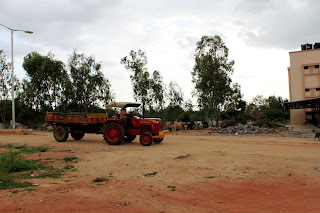













On Wednesday Emily, Cecilia, Shera and I set out to find a temple so that Emily could sacrifice a coconut to the healing gods for a friend who had been in an accident. Coconut sacrifices are common for women who are hoping to find a husband or become pregnant, but are also popular for healing requests. We caught a rickshaw from the main gate and headed in the direction of a temple...any temple. To our surprise we ended up at one we had be to for the Banalu Festival. We took our shoes off and walked through the gate. With no idea what to do from here we wandered around a bit until we saw a sign with an arrow buy coconuts here, quite convenient. It brought us to a stand where a man was already holding out two coconuts. I thought to myself Derick has a bad back, the doctors couldn’t do much, let’s see what Lord Krishna has up his sleeve. Emily and I paid for our coconuts and walked into the temple. After more aimless wandering we heard a loud crack. We followed our ears and found the man who breaks the coconuts. He sat next to a shrine. We watched some other women go through the process before trying our hand at it. He waved us in and took the coconut, slamming it onto the stone as we folded our hands in the direction of the shrine and he asked “Where you from? U.S?” As we nodded he put a bindi (red dye) on each of our foreheads and shooed us along to make way for the next group. We then found our way to the wall where all of the coconuts were hanging. Behind the wall there were five different statues of Krishna (I think). After folding our hands and saying a few Hare Krishnas (Hail Krishna) we tied the coconut bags to the wall. If we thought we were done there we were mistaken. In my experience Hindus are very welcoming to foreigners at the temples and as we stick out so much they tend to single you out and want to show you around. Like the last time they brought us to the head of the line for the main shrine of Durga. We were just in time for the ceremony where they light the candle and everyone waves smoke on to themselves. Then they bring around some special water that we had previously been instructed to take in our hand, pretend to drink and then throw on our hair. After this we were free to go.










